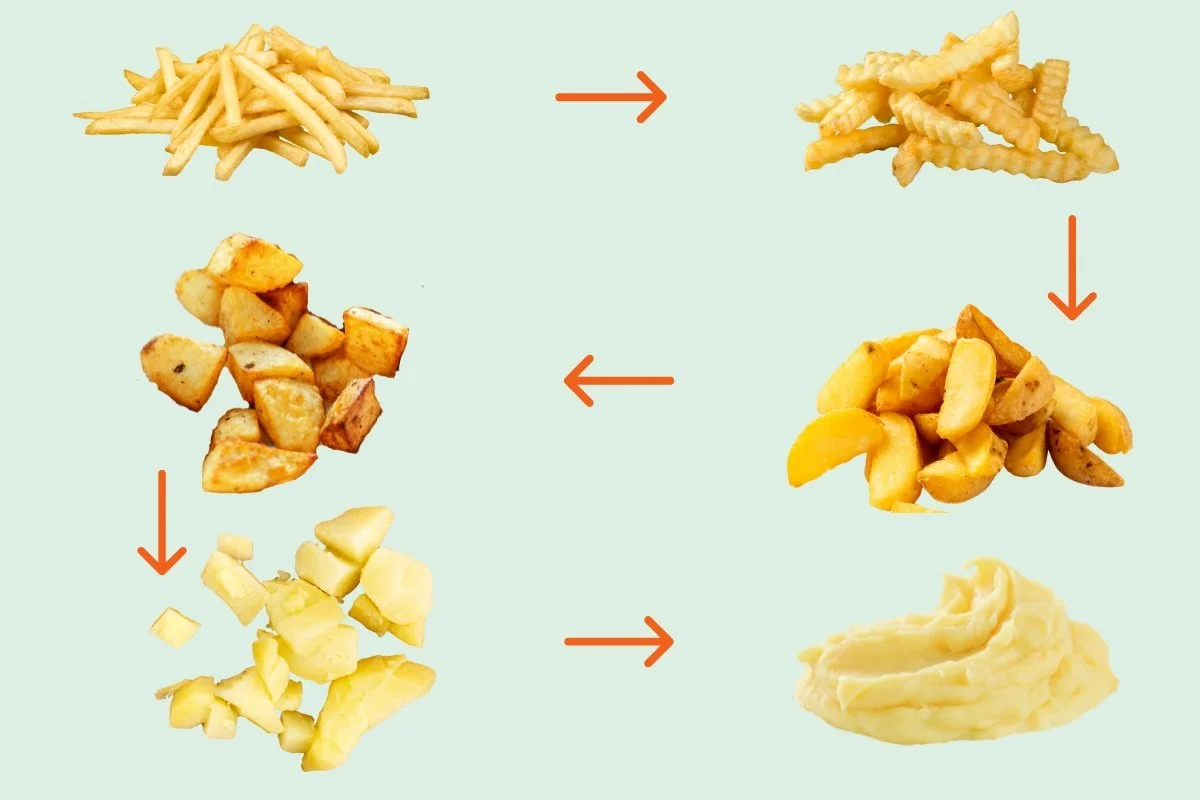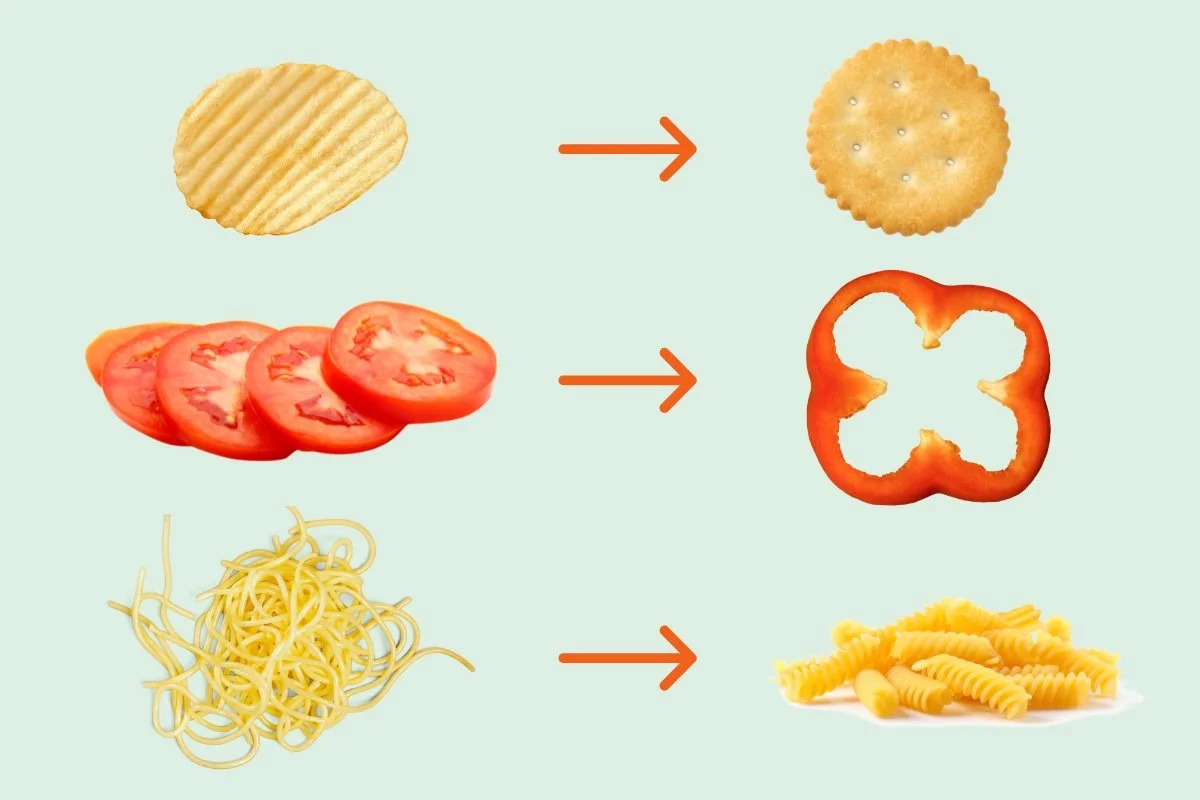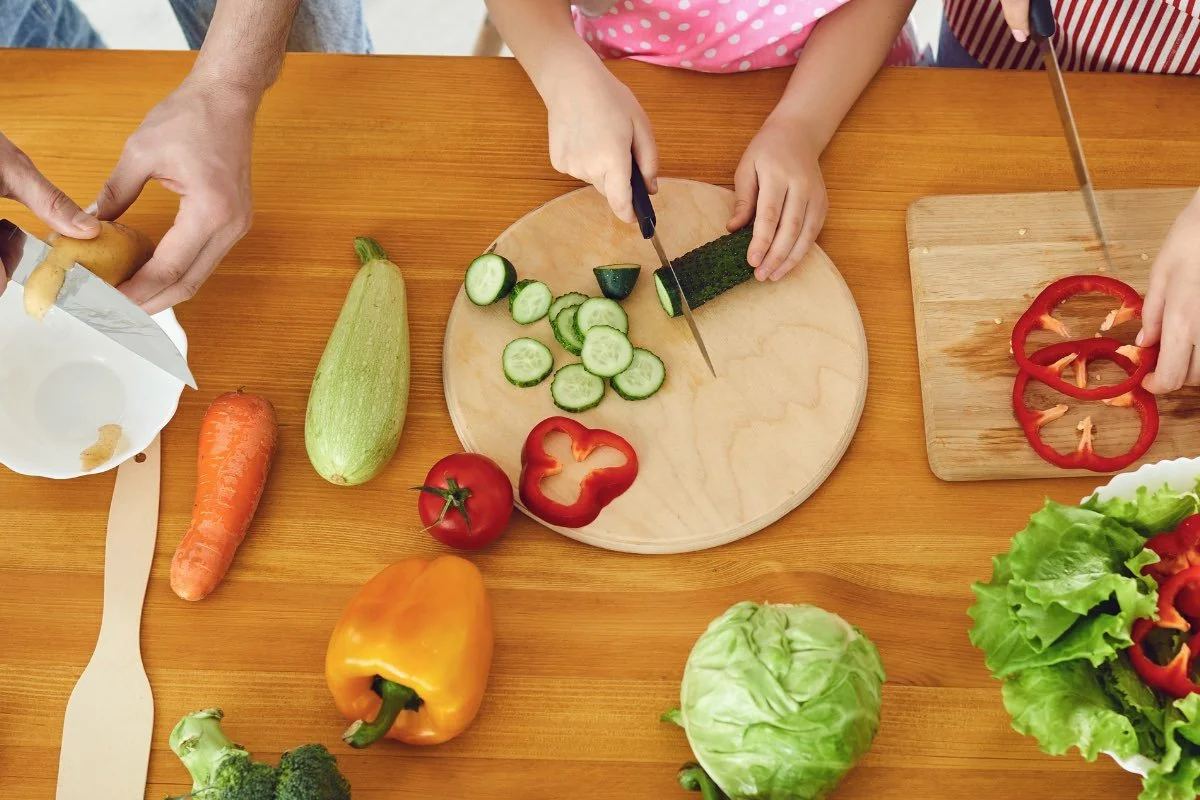The Ultimate Guide to Food Chaining for Picky Eaters
Picky eating can be so tough to navigate as a parent.
You just want your child to eat something vaguely nutritious, but they flat-out refuse to even try what you offer.
It can feel like you’re making zero progress… or worse, like things are going backwards.
But, you don’t have to give up entirely!
There is a way forward that doesn’t involve bribery, power struggles, or giving in to your child’s demands for plain pasta or chicken nuggets…yet again.
Food chaining is a gentle, step-by-step approach to help your child gradually expand their list of accepted foods in a low-pressure way.
What is food chaining?
Food chaining involves creating a little ‘chain’ between the foods your child already likes and accepts and the ones you’d like them to eat.
It was originally developed by speech-language therapists Cheri Fraker and Laura Walbert, and it works by gradually introducing new foods that are just one small step away from what your child already eats.
The idea is to make changes so subtle that your child doesn’t feel threatened, but still gets exposed to new tastes, textures, shapes, and colors.
Over time, this builds their confidence and their list of accepted foods - without the drama.
Don’t despair, there’s light at the end of the chicken nugget tunnel…
Why food chaining works
If you’re the parent of a picky eater (I’m right there with you 🙋♀️), you probably know the cycle:
Option one: you serve the foods you wish they’d eat, they refuse, you get frustrated, and everyone ends up upset.
Option two: you just give in and serve their ‘safe’ foods on repeat, because at least then you know they’ll eat something.
Neither feels great. One ends in tears, and both end in worry and frustration.
Food chaining offers a middle ground. A way to gently move your child forward while still keeping the peace at the table.
Because when kids feel safe, they’re much more likely to explore. And when you’ve got a plan, you feel calmer too.
Related Article: 10 tips for coping with a picky eater (that are actually helpful…)
Food chaining methods
The trick with food chaining is to find tiny, subtle ways to build a bridge from your child’s ‘safe’ foods to new ones.
Here are a few easy ways to create that bridge:
1.Texture progression
If your child only eats smooth yogurt, jumping straight to a chunky fruit yogurt is going to be a hard no.
Instead, go slow.
First, offer their favorite yogurt with a tiny swirl of fruit puree mixed in. Then try yogurt with small fruit chunks.
Step by step, you’re helping them feel more comfortable with different textures without it being overwhelming.
2. Color matching
Kids are visual eaters. If it looks familiar, they’re more likely to give it a go.
So, use color to your advantage.
For example, if your child loves tomato, try offering red capsicum. If they happily eat white bread, introduce plain rice cakes.
These foods are more likely to feel ‘safe’ because the color matches, but it’s still a new food.
3. Shape swaps
Sometimes it’s not the food itself, but the way it looks.
If your child eats pasta shells but refuses spaghetti, try mixing a few different shapes together in the same bowl.
Start small - mostly their favorite shape, with one or two new ones mixed in. Over time, increase the ratio.
The key with all of these methods? Keep the changes tiny. If it feels like a big leap, your child will notice and shut it down. But if it’s just a little nudge, they’re much more likely to give it a chance.
Getting started with food chaining
So, where do you actually start with food chaining?
Here’s a step-by-step guide to gently expand your child’s food repertoire:
1. Rule out any underlying causes
Before you begin, it’s important to check in with your GP or a feeding therapist if your child is extremely picky.
Some children have sensory sensitivities, digestive issues, or other medical conditions that can make certain textures or tastes overwhelming.
Addressing these first ensures your approach is safe and tailored to your child’s needs.
2. Write down your child’s favorite (aka ‘safe’) foods
Most picky eaters have a short list of foods they consistently accept.
Write them down, even if you already know them inside out - this becomes the foundation of your food chain.
Knowing exactly what your child enjoys helps you plan gradual, achievable steps toward new foods.
3. Look for ‘food cousins’
Next, find foods that are similar to their favorites in taste, texture, shape, or color.
For example, if your child loves smooth yogurt, you might try adding a tiny amount of fruit puree or a subtly flavored yogurt. The goal is to make the new food feel familiar and safe, rather than completely foreign.
4. Talk about the plan
Include your child in the process. Explain that you’re trying new foods together, and celebrate small wins as a team.
Framing it as a shared adventure reduces pressure and helps your child feel in control and curious rather than forced.
5. Take tiny steps
Introduce new foods in very small increments - a little taste of a new flavor or a tiny piece of a different texture.
Serve it regularly, without insisting they eat it.
Repetition is key - seeing and smelling the food often helps reduce anxiety and increases acceptance over time.
6. Encourage curiosity
Let your child touch, smell, or play with the food before eating.
This helps them explore without pressure, turning mealtimes into a safe and playful experience.
Eating is the final step - the goal is to build comfort and familiarity first.
Food chaining examples
Here are a few real-life examples of food chaining in action:
Chicken nuggets → chicken tenders → homemade crumbed tenders → lightly breaded baked chicken → grilled chicken strips
Plain pasta → pasta with a sprinkle of cheese → pasta with a tiny bit of tomato sauce → pasta with a little more sauce
Applesauce → chunky applesauce → well-cooked stewed or baked apple slices → semi-cooked apple slices → raw apple slices
Toast → toast with a thin spread of peanut butter → peanut butter toast topped with banana slices
French fries → thicker oven-baked fries → roasted potato wedges → diced roasted potatoes → mashed potato
Yoghurt (plain or flavoured) → yoghurt with a drizzle of honey → yoghurt with soft fruit purée → yoghurt with small fruit chunks → yoghurt parfait with granola and berries
Chicken soup (strained/broth only) → soup with tiny soft noodles → soup with small vegetables → chunkier chicken and vegetable soup
See how small those steps are? That’s the point.
Tips for success
Be patient
Food chaining is a slow and steady process.
Progress can feel like two steps forward and one step back — and that’s completely normal. Some days your child may surprise you and take a big leap, while other days they may refuse a food they happily ate yesterday.
Remember: every small step counts. Even touching, smelling, or licking a new food is progress worth celebrating.
Don’t panic
If your child skips a meal, try not to stress.
Most kids are surprisingly good at regulating their intake over time. Missing one meal doesn’t mean they’ll miss out on nutrition overall - chances are they’ll make up for it at the next snack or mealtime.
Staying calm helps keep pressure off both you and your child, which makes eating feel less like a battle.
Make it fun
When kids are engaged and having fun, they’re more likely to explore and try something new - so try turning food into an adventure rather than a chore.
You could:
Cut foods into shapes with cookie cutters
Give foods silly names (e.g., ‘x-ray vision carrots’)
Serve dips and sauces for dipping. Children’s intake of vegetables has been shown to increase when they’re paired with dips
Involve your child in shopping, washing, or preparing foods
Pretend to be a waiter in a restaurant while your kids are the diners (my kids love this one!)
Stay positive
Your encouragement goes a long way so remember to praise your child’s willingness to explore, even if they don’t actually eat the food.
Positive reinforcement helps your child feel safe and confident around new foods without pressure.
Keep mealtimes calm
Stress and tension at the table can quickly dampen a child’s appetite.
Aim to create a relaxed, low-stress mealtime atmosphere by:
Sticking to a predictable routine so kids know when to expect meals and snacks
Serving small portions of new foods alongside familiar favourites
Avoiding pressuring your child to eat certain foods - it often backfires
When the dinner table feels calm, kids are more open to exploring new foods at their own pace.
Use small, non-food rewards
Research shows that using small non-food rewards, like stickers or praise, can help kids feel more positive about trying vegetables - and over time, this gentle encouragement can even build a genuine liking of veg.
Unlike bribery or pressure (e.g., ‘no dessert until you finish your broccoli’), these rewards aren’t about punishment or control, but about making new foods feel fun and safe to explore.
Non-food rewards work best when paired with repeated exposure, a calm eating environment, and positive modelling by adults.
Lead by example
Children are natural imitators (as you’ve no doubt noticed!).
If they see you trying, enjoying, and talking positively about a variety of foods, they’re more likely to follow your lead.
Share meals together whenever possible, and let your child watch you explore new flavours with curiosity. Even casual comments like, ‘This cucumber is really crunchy!’ can spark their interest.
Celebrate the small wins
Food chaining isn’t about getting your child to love every food overnight - it’s about building small bridges over time.
Keep track of little wins and remind yourself that each step is a foundation for the next.
Common food chaining pitfalls to avoid
While food chaining can be highly effective, there are a few common traps that can slow progress or create extra stress at mealtimes:
Pressuring your child to eat
Statements like ‘Just one bite’ or ‘You can’t leave the table until you try it’ may feel harmless, but they often increase anxiety and resistance and can reinforce picky eating.
Pressure turns eating into a power struggle rather than a positive experience.
Hiding foods
While blending spinach into a smoothie or zucchini into muffins can boost nutrition, relying on sneaky strategies doesn’t actually teach children to accept those foods.
It’s fine to add vegetables to meals and snacks, but don’t try to hide them.
True food acceptance comes from exposure, not disguise.
Offering too many new foods at once
A plate full of unfamiliar foods can feel overwhelming. Start small by pairing one new food with a couple of accepted, familiar options.
Consistent, low-pressure exposure works best.
Expecting overnight success
It can take 10, 20, or even more exposures before a child accepts a new food.
If you give up too quickly, you may miss the chance for progress.
Think of it as a marathon, not a sprint.
Keep in mind…
Food chaining isn’t about forcing your child to eat foods they hate. It’s about helping them gently branch out from what they already know - one small, safe step at a time.
Remember, progress doesn’t always look like eating a whole plate of new foods. Sometimes it’s just a lick, a nibble, or even allowing a new food to sit on the plate without fuss. Every little step is moving in the right direction.
Most importantly, remember this: your child’s picky eating is not a reflection of you as a parent. You’re doing an amazing job just by showing up and trying new strategies.
Don’t go it alone
If you find yourself feeling stuck or worried about your child’s nutrition, you don’t have to navigate it alone.
A pediatric dietitian can help you to reduce mealtime stress and support your children to develop a healthier, more varied diet.
If you’d like personalised guidance for your child, I’d love to help.












